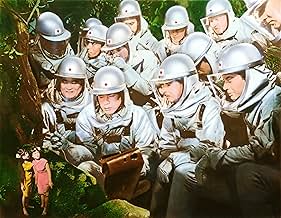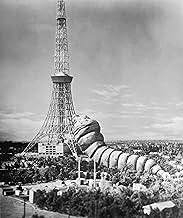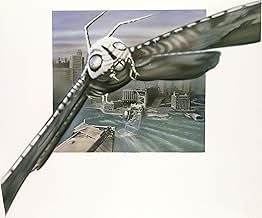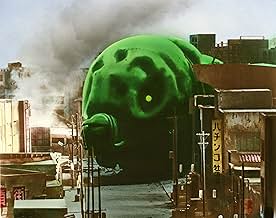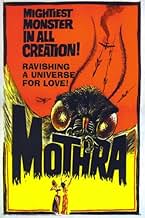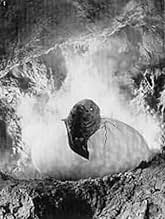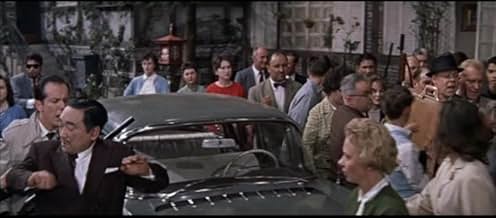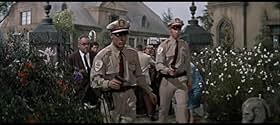Aggiungi una trama nella tua linguaAn expedition to Infant Island uncovers a native tribe and twin tiny fairy priestesses of a mythical deity, who sets out to rescue the pair after they are kidnapped by a greedy businessman.An expedition to Infant Island uncovers a native tribe and twin tiny fairy priestesses of a mythical deity, who sets out to rescue the pair after they are kidnapped by a greedy businessman.An expedition to Infant Island uncovers a native tribe and twin tiny fairy priestesses of a mythical deity, who sets out to rescue the pair after they are kidnapped by a greedy businessman.
- Regia
- Sceneggiatura
- Star
- Premi
- 2 candidature totali
- Shobijin (Twin Fairy)
- (as Yumi Ito)
- Shobijin (Twin Fairy)
- (as Emi Ito)
- Kurâruku Neruson
- (as Jerî Itô)
- Military Advisor
- (as Yoshibumi Tajima)
- Nelson's Henchman
- (as Hiroshi Iwamoto)
- Ship Survivor
- (scene tagliate)
Recensioni in evidenza
Nothing much to say about this one. I only knew Mothra as an adversary to Godzilla and was interested in seeing the film where he debuts and predates his epic fight with the lizard of destruction. It is a good story and gets to the heart of the Mothra myth with the singing fairies that summon him.
While maybe not as iconic as Godzilla, Mothra is a kaiju worthy of his own film series (which he has), and those interested in Toho's work really ought to check it out.
If the original Godzilla was the '50s classic kaijyu movie, this is that of the '60s, spawning many movies that follows featuring Mothra.
This movie was created on the following year Japan signed the "Treaty of mutual cooperation and security between Japan and U.S." of 1960 and reflects the politically charged atmosphere against US at the time in Japan. For instance, country Rorisika is a combined name of Russia, and America (in the original novel, the name was even more obvious Russirica, but was changed for the world wide release of the movie), and New Kirk city is an obvious synonym for New York city. US and Russia by the way were the only countries in the world performing hydrogen bomb experiments at the time, and No. 2 Genyomaru's, encounter with the test was also a hidden criticism against these experiments.
In the original novel, the location where Mothra spews the cocoon is the parliament building, but this was viewed as a political statement against the said treaty, and was changed to Tokyo tower. The movie features a real life twins The Peanuts (Emi and Yumi Eto) who were popular singers in Japan at the time. The Mothra song they sang were written by Tomoyuki Tanaka, Ishiro Honda, and Shinichi Sekizawa first in Japanese, and Indonesian student residing in Japan at the time translated it into his language. The original manuscript of this handwritten song is now displayed in Yuji Koseki (who was the composer for this song) museum in Fukushima city Japan.
The plot and special effects are tour de force. One of Mothra's lava costumes had 8 men in it with Godzilla suit actor Haruo Nakajima taking the lead. Mothra is the first kaijyu that's not just out for destruction, but is a protector of the environment. When the Mothra lava spews silk, it really looks real. The silk was made from rubber contact cement thinned down with solvent and shot out of Mothra's mouth using air brush. Actor Hiroshi Koizumi reprises his role as Shinichi Chujyo in 2003 movie Godzilla vs Mecha Godzilla Tokyo SOS after 42 years this movie was made.
Still after half a century, this is one of the best kaijyu movie ever created.
Unlike the other monsters, Mothra can die, and has done so. But it continues to protect its people by reproducing the old fashioned way--it lays eggs. IT is also intelligent and intuitive, and its nature is NOT aggressive or violent. It's almost Buddhist in nature.
The only other time they tried to work this kind of mysticism into these movies was with King Cesar--a giant cocker spaniel with contacts. The beast was just too goofy to be taken seriously.
Mothra is a great addition to the canon.
A greedy showman/explorer Clark Nelson (Jerry Ito) finds twin fairies on an island off Japan. He displays them on the Tokyo stage, where they sing what sounds like a lullaby. It is actually a telepathic distress call to their god and protector, Mothra, a giant caterpillar. Mothra comes to Tokyo, searching for the girls and Nelson, destroying most of the city in it's path. The chase goes from Tokyo to Newkirk City (I guess this is suppose to be a little real life hamlet just south of Yonkers!) What I really love about MOTHRA is that it has many things most other monster movies don't. The hero is a comical, older, tubby reporter, a sort of Japanese Lou Costello. The monster is actually pretty. In the Japanese version, there is some wonderful slapstick and odd humor. THese elements make this film so unique. Director Inoshiro Honda was best friends with more famous and more respected Japanese director Akira Kurosawa. Kurosawa loved Honda's monster movies and according to rumor, yearned to make one himself.
Lo sapevi?
- QuizThe Mothra larva was the largest costume Toho would create in the Showa era. The Mothra larva seen rampaging through Tokyo's neighborhood was about 7 feet tall and just over 31 feet long. Weighing about 265 pounds (120 kilograms), a total of eight actors were needed to perform and operate the Mothra larva.
- BlooperWhen Dr. Shinichi is showing the symbols he discovered in the cave to Senchan, you can see someone in black pants and shoes walking down the stairs behind Senchan's head.
- Citazioni
[the protagonists confront Nelson to return Mothra's fairies back to Infant Island]
Dr. Shinichi Chujo: I want you to stop this inhumanity and return them to their island.
Nelson's Henchman: Inhumanity? Ridiculous. Strictly speaking they're just scientific data.
Clark Nelson: Those fairies aren't human. They're merchandise.
- Curiosità sui creditiIn the credits for the U.S. version, including promo material released by Columbia Pictures, Eurasian model Jerry Ito (who plays the villianous Mr. Nelson) is billed as "Jelly Ito."
- Versioni alternativeThe American Version also edited the birth of Mothra sequence, cutting out a good 40 seconds to make it more elaborate
- ConnessioniEdited into L'invasione degli astromostri (1965)
I più visti
Dettagli
Botteghino
- Lordo in tutto il mondo
- 90 USD
- Tempo di esecuzione1 ora 41 minuti
- Mix di suoni
- Proporzioni
- 2.35 : 1
Contribuisci a questa pagina




